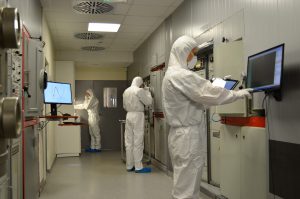EBE – Electron beam evaporation
EBE | TE

During electron beam evaporation, electron beam is employed to heat coating material within a water-cooled crucible. Size and moving pattern of electron beam can be optimized and controlled to ensure maximally uniform evaporation of molten material. Material vapor is condensing on rotating substrates within vacuum chamber, forming a layer. Additional oxygen gas is usually added to ensure full oxidation of a film. Substrates usually are heated up to 150 – 350 °C to increase mobility of condensing particles and to enhance oxidation. Due to its effectiveness, electron beam evaporation (EBE) has been widely used for many years as one of the main coating technologies. Different metal oxides, fluorides, selenides, sulfides might be successfully coated using this technology.
Thermal evaporation (TE) is even older deposition technology, which had emerged in the end of XIX century. Its principle relies on direct heating of material filled boat (made from molybdenum, tantalum, tungsten, etc.) by high electrical current. In this way, material melts, evaporates and condenses on the substrates. TE is usually used for evaporation of metal fluorides and metals; therefore, it is still the main technology for making dielectric coatings for vacuum UV (VUV) – deep UV (DUV) range, as well as for metallic mirrors.
- Main advantages
- Disadvantages
- Cost effectiveness;
- Evaporation of metal fluorides (coatings for DUV range), metal selenides, sulfides (coatings for IR range);
- High LIDT in UV spectral range;
- Low stress an porosity of coating allows wide choice of substrate materials (even soft, sensitive and exotic crystals).
- Low energy (~0.1 eV) of condensing particles, leading in considerably porous coatings. That means absorption of moisture, sensitivity to changes in environmental conditions (humidity and temperature);
- Due to necessity of heating the substrates, deposition on temperature sensitive substrates is hardly possible;
- Usually polycrystalline microstructure and layer porosity leads to considerable interface and surface roughness, resulting in additional scatter losses;
- Due to many process variables, changes in spatial vapor flume distribution and non-uniform vacuum-air shift of different coating layers, realization of coatings having complex spectral properties is limited.